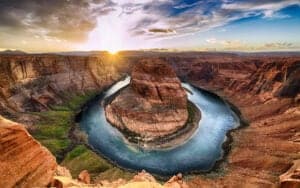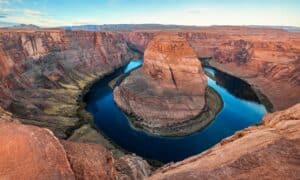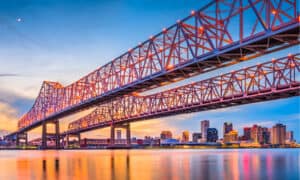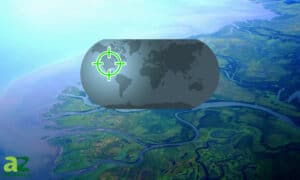What is a River? What You Must Know
When you think about the various bodies of water that exist, it may seem simple to differentiate between a lake and a river or a stream and a lake. At least, it seems that way on the surface. Today, we’re going to answer a very simple question: what is a river? As you might imagine, there is more to the answer than water.
By the time we’re done, you’ll know what makes this body of water unique and how it stands apart from others. You’ll know how to tell a river from a stream and learn about the biggest river in the world!
What is a River?

Harald L. Vaagan/Shutterstock.com
| Factor | Application to River |
|---|---|
| Water Movement | – A moving body of water – Typically has a swift current due to the river’s flow facilitated by gravity |
| Boundaries | – Bounded by a riverbank – Flows from one area and outlets into another body of water, like an ocean |
| Creation | – Naturally occurring – Flow of water can be changed with dams, but rivers can’t be man-made |
| Water Type | – Vast majority are freshwater – The water turns brackish near sea outlets |
A river is a naturally occurring moving body of water with boundaries that drains into another body of water, typically other rivers or oceans. For the most part, rivers are completely freshwater since they are fed by precipitation.
These bodies of water are natural. They cannot be man-made like a lake. Of course, the flow of a river is something that can be altered. For example, the Mississippi River in the United States is poised to change its flow. Currently, the river flows through Baton Rouge and New Orleans out to the Gulf of Mexico.
However, the river’s present course would change without a series of projects including the Old River Control Structure. Without that structure in place, the river would likely flow west and then south, bypassing Baton Rouge and New Orleans.
As we’ve said, rivers are freshwater. However, rivers can become brackish as they approach their outlet, but only if their mouth is the ocean. At those points, the seawater will mix with freshwater, creating unique water conditions.
If the river flows into another body of water, then it will continue as a freshwater body of water.
How Are Rivers Formed?
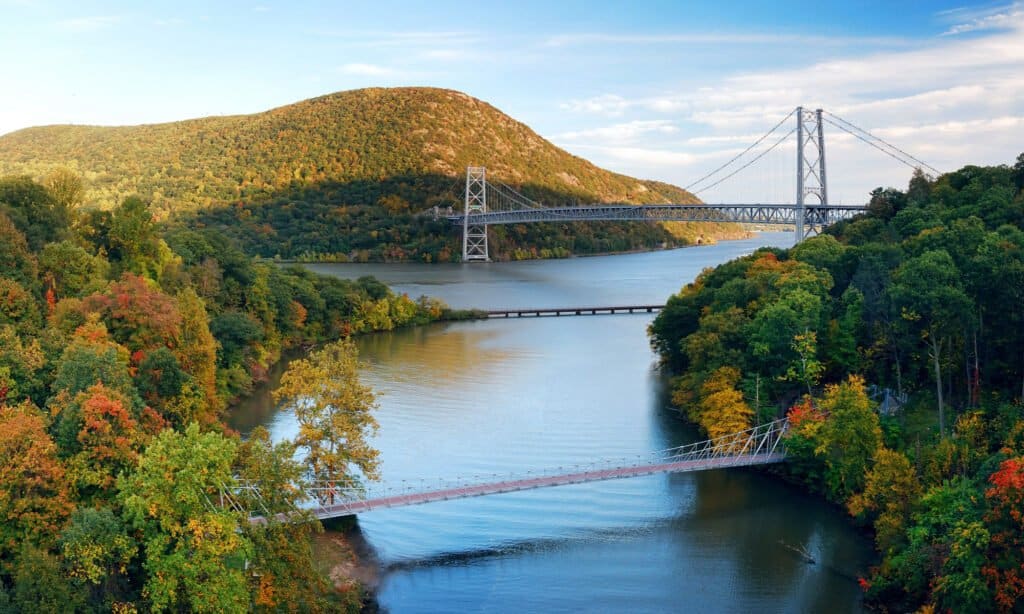
Songquan Deng/Shutterstock.com
We have now answered, what is a river? Yet, we didn’t go in-depth about how rivers form. The condensed version is as follows:
- The water cycle causes rain in high altitudes
- The water flow from that rain collects in streams as it accelerates downhill
- The streams continue to flow and eventually unite into lakes, creeks, or small rivers
- A river starts at a headwater and flows toward another, larger body of water
- The river receives tributary waters from other streams and rivers, continuing to carve a path across the land
- Eventually, the river reaches a mouth, sometimes forming a delta at the ocean or merely flowing into another body of water
These are the basic steps to river formation, and it’s only a brief summary. The creation and flow of rivers is such a significant topic that volumes have been written on the subject.
What Are the Most Important Parts of a River?

Jeffrey T. Kreulen/Shutterstock.com
Many parts of a river exist, and they are all rather important to know about if you wish to know how rivers work. Take a look at some of the terms and definitions that you should know to bolster your knowledge of rivers.
- Drainage Basin: a large area in which precipitation gathers and runs into a common outlet, referring both to the water that runs on the surface as well as groundwater.
- The Amazon River Basin is the largest in the world, draining over 3 million square miles.
- Headwaters: the source or official start of a river
- For example, Lake Itasca of Minnesota contains the headwaters of the Mississippi River.
- Flow: the water within the river; the direction in which the river is moving
- The flow of the Amazon River is roughly west to east
- Tributary: streams or rivers that contribute water to the river
- The Ohio River is a major tributary of the Mississippi River, contributing significant amounts of water to the river’s flow.
- Confluence: the place where two rivers meet and continue to flow together as a single entity
- The Blue Nile and the White Nile create meet at the confluence that creates the Main Nile River.
- Mouth: the place where a river flows into another body of water; the end of the river
- The mouth of the Mississippi River is at the Gulf of Mexico
This list of six important parts of a river should help you get a basic grasp of river terminology. These definitions lack some nuance, but they are serviceable. However, there are far more parts to a river, and the formation of these rivers is immensely complicated.
What is the Largest River in the World?
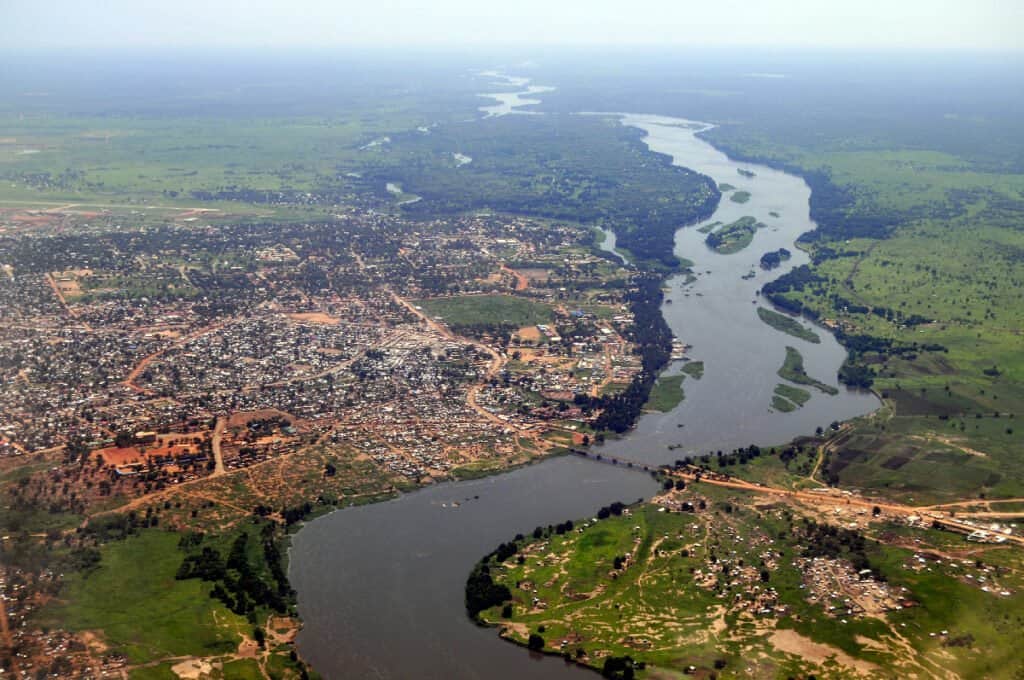
iStock.com/Phototreat
The Nile River and Amazon River compete for the title of the largest river in the world. Amazingly, there is no clear-cut answer of which is longer as measurements for the Amazon River range between 3,977 miles and 4,388 miles. The source of the inconsistency is which headwaters are used for the Amazon (some tributaries feeding into the Amazon are longer, but don’t run throughout the year) and where to measure the Amazon as its delta expands across a wide area.
Likewise, the Nile River is commonly cited at more than 4,100 miles, with some estimates stretching as far as 4,258 miles. Once again, inconsistent measurements come from the fact that headwaters of the Nile are in swampy areas where it’s hard to gauge where exactly the river beings. While both rivers are similar in terms of length, the Amazon carries substantially more water.
Rivers are complex bodies of water that are found throughout the world. Although it’s easy to define them by their flow, freshwater, and formation, they can be similar to other bodies of water. However, with the information we have provided here, you should be prepared to tell a river from a lake, sea, or even an estuary.
Also, now that you know the basics about rivers, it may be worth looking at them in greater detail. River formations and unique areas like deltas are worth knowing about!
Rivers are often confused with canals. Read about the differences between a river and a canal.
More from A-Z Animals
When you think about the various bodies of water that exist, it may seem simple to differentiate between a lake and a river or a stream and a lake. At least, it seems that way on the surface. Today, we’re going to answer a very simple question: what is a river? As you might imagine, there is more to the answer than water.
By the time we’re done, you’ll know what makes this body of water unique and how it stands apart from others. You’ll know how to tell a river from a stream and learn about the biggest river in the world!
What is a River?

Harald L. Vaagan/Shutterstock.com
| Factor | Application to River |
|---|---|
| Water Movement | – A moving body of water – Typically has a swift current due to the river’s flow facilitated by gravity |
| Boundaries | – Bounded by a riverbank – Flows from one area and outlets into another body of water, like an ocean |
| Creation | – Naturally occurring – Flow of water can be changed with dams, but rivers can’t be man-made |
| Water Type | – Vast majority are freshwater – The water turns brackish near sea outlets |
A river is a naturally occurring moving body of water with boundaries that drains into another body of water, typically other rivers or oceans. For the most part, rivers are completely freshwater since they are fed by precipitation.
These bodies of water are natural. They cannot be man-made like a lake. Of course, the flow of a river is something that can be altered. For example, the Mississippi River in the United States is poised to change its flow. Currently, the river flows through Baton Rouge and New Orleans out to the Gulf of Mexico.
However, the river’s present course would change without a series of projects including the Old River Control Structure. Without that structure in place, the river would likely flow west and then south, bypassing Baton Rouge and New Orleans.
As we’ve said, rivers are freshwater. However, rivers can become brackish as they approach their outlet, but only if their mouth is the ocean. At those points, the seawater will mix with freshwater, creating unique water conditions.
If the river flows into another body of water, then it will continue as a freshwater body of water.
How Are Rivers Formed?

Songquan Deng/Shutterstock.com
We have now answered, what is a river? Yet, we didn’t go in-depth about how rivers form. The condensed version is as follows:
- The water cycle causes rain in high altitudes
- The water flow from that rain collects in streams as it accelerates downhill
- The streams continue to flow and eventually unite into lakes, creeks, or small rivers
- A river starts at a headwater and flows toward another, larger body of water
- The river receives tributary waters from other streams and rivers, continuing to carve a path across the land
- Eventually, the river reaches a mouth, sometimes forming a delta at the ocean or merely flowing into another body of water
These are the basic steps to river formation, and it’s only a brief summary. The creation and flow of rivers is such a significant topic that volumes have been written on the subject.
What Are the Most Important Parts of a River?

Jeffrey T. Kreulen/Shutterstock.com
Many parts of a river exist, and they are all rather important to know about if you wish to know how rivers work. Take a look at some of the terms and definitions that you should know to bolster your knowledge of rivers.
- Drainage Basin: a large area in which precipitation gathers and runs into a common outlet, referring both to the water that runs on the surface as well as groundwater.
- The Amazon River Basin is the largest in the world, draining over 3 million square miles.
- Headwaters: the source or official start of a river
- For example, Lake Itasca of Minnesota contains the headwaters of the Mississippi River.
- Flow: the water within the river; the direction in which the river is moving
- The flow of the Amazon River is roughly west to east
- Tributary: streams or rivers that contribute water to the river
- The Ohio River is a major tributary of the Mississippi River, contributing significant amounts of water to the river’s flow.
- Confluence: the place where two rivers meet and continue to flow together as a single entity
- The Blue Nile and the White Nile create meet at the confluence that creates the Main Nile River.
- Mouth: the place where a river flows into another body of water; the end of the river
- The mouth of the Mississippi River is at the Gulf of Mexico
This list of six important parts of a river should help you get a basic grasp of river terminology. These definitions lack some nuance, but they are serviceable. However, there are far more parts to a river, and the formation of these rivers is immensely complicated.
What is the Largest River in the World?

iStock.com/Phototreat
The Nile River and Amazon River compete for the title of the largest river in the world. Amazingly, there is no clear-cut answer of which is longer as measurements for the Amazon River range between 3,977 miles and 4,388 miles. The source of the inconsistency is which headwaters are used for the Amazon (some tributaries feeding into the Amazon are longer, but don’t run throughout the year) and where to measure the Amazon as its delta expands across a wide area.
Likewise, the Nile River is commonly cited at more than 4,100 miles, with some estimates stretching as far as 4,258 miles. Once again, inconsistent measurements come from the fact that headwaters of the Nile are in swampy areas where it’s hard to gauge where exactly the river beings. While both rivers are similar in terms of length, the Amazon carries substantially more water.
Rivers are complex bodies of water that are found throughout the world. Although it’s easy to define them by their flow, freshwater, and formation, they can be similar to other bodies of water. However, with the information we have provided here, you should be prepared to tell a river from a lake, sea, or even an estuary.
Also, now that you know the basics about rivers, it may be worth looking at them in greater detail. River formations and unique areas like deltas are worth knowing about!
Rivers are often confused with canals. Read about the differences between a river and a canal.

